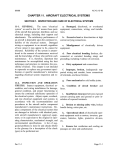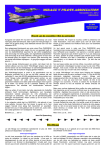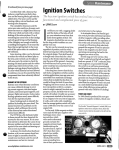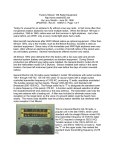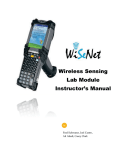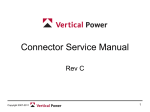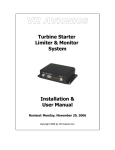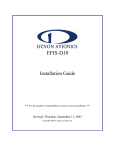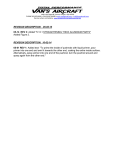Download Aircraft Electrical Systems ( PDF file)
Transcript
Aircraft Electrical Systems Princeton Airport Flying Tigers Presented by Ernie Schirmer Why Study Electrical Systems? · To enable a pilot to get a better understanding of how the aircraft’s electrical system operates which will enable the pilot to maintain and operate the aircraft more safely and respond more confidently to emergencies. Learning Objectives · Objectives To present an overview of basic electrical concepts (e.g. voltage, current and resistance). To review which aircraft instruments are typically electrically powered. To understand the electrical system of simple aircraft To review failure modes and simple troubleshooting techniques. Preventive Maintenance What Maintenance Can An Owner or Pilot Perform? FAR 43.3(g) “The holder of a pilot certificate issued under Part 61 may perform preventive maintenance on any aircraft owned or operated by that pilot which is not used under Part 121, 129, or 135.” Based on 14 CFR Ch. 1 (1-1-03) Edition What Maintenance Can An Owner or Pilot Perform? FAR 43.13(a) “Each person performing maintenance … shall use the methods, techniques, and practices prescribed in the current manufacturer’s maintenance manual or Instruction for Continued Airworthiness prepared by its manufacturer, or other methods, techniques, and practices acceptable to the Administrator except as noted in Section 43.16.” What Maintenance Can An Owner or Pilot Perform? FAR 43.13(a) “He shall use the tools, equipment, and test apparatus necessary to assure completion of the work in accordance with accepted industry practices. If special equipment or test apparatus is recommended by the manufacturer involved, he must use that equipment or apparatus or its equivalent acceptable to the Administrator.” What Maintenance Can An Owner or Pilot Perform? FAR 43.13(b) “Each person … performing preventive maintenance, shall do that work in such a manner and use materials of such a quality, that the condition of the aircraft … worked on will be at least equal to its original or properly altered condition … ” What Maintenance Can An Owner or Pilot Perform? FAR 43 Appendix A (c) “Preventive Maintenance is limited to the following work, provided it does not involve complex assembly operations: (16) Troubleshooting and repairing broken circuits in landing light wiring circuits. (17) Replacing bulbs, reflectors, and lenses of position and landing lights. (24) Replacing and servicing batteries.” What Maintenance Can An Owner or Pilot Perform? FAR 43 Appendix A (30) “The inspection and maintenance tasks prescribed and specifically identified as preventive maintenance in a primary category aircraft type certificate or supplemental type certificate holder’s approved special inspection and preventive maintenance program when accomplished on a primary category aircraft … “ The Paperwork FAR 43.9 (a) “ … each person who … performs preventive maintenance … shall make an entry in the maintenance record of that equipment containing the following information: (1) a description … of work done. (2) the date of completion of the work (3) the name of the person performing the work …“ The Panel Mechanical Instruments Attitude Indicator Airspeed Vertical speed Directional Gyro Oil pressure Tachometer Suction gage Magnetic compass Stall warning Electrically-powered Instruments Pitot heater Oil temp gage Exhaust gas temperature (EGT) Fuel gages Engine hour meter (“Hobbs”) Turn-and-Slip indicator Turn coordinator Clock The Manual Cessna 172N Manual Cessna 172N Manual Cessna 172N Manual Electrical Concepts Electrical Units of Measure Voltage (pressure) ± unit of measure is the Volt Current (flow) ± unit of measure is the Ampere (amp) Resistance (friction) ± unit of measure is the Ohm Power (force) ± unit of measure is the Watt Electrical Symbols Voltage – Voltage symbol is traditionally “E” for ElectroMotive Force (EMF) Current – Current symbol is traditionally “I” for Intensity Resistance – Resistance symbol is “R” in equations and the Greek symbol omega Ω for values Power – Power symbol may be “P”ower or “W”atts The Equations E = I*R Voltage = Current times Resistance P = E*I Watts = Voltage times Current Landing Light Problem Switch 24-volt Battery What is the resistance (in ohms) of the landing light? Landing 9 Amps Light What is the power (wattage) Actual return path is via aircraft skin of the landing light? Landing Light Resistance Calculation E = I*R 24 = 9*R 24/9 = 9*R/9 2.7 ohms = R The resistance of the landing light is 2.7 Ω Landing Light Power Calculation P = E*I P = 24*9 P = 216 watts Landing Light Schematic Starter Motor Problem Starter Relay Contacts Ignition Switch 24-volt Battery What happens Starter if the Motor resistance of the relay 150 Amps contacts increases from Starter 0.01 ohms to .1 Relay ohms? Coil Starter Motor Voltage Drop Calculation Part 1 E = IR E = 150*0.01 E = 1.5 volts 24 - 1.5 = 22.5 volts available to starter motor Starter Motor Voltage Drop Calculation Part 2 E = IR E = 150*0.1 E = 15 volts 24 - 15 = 9 volts available to starter motor Starter Motor Power Calculation P = E*I P = 24*150 P = 3,600 Watts 746 watts = 1 horsepower 3,600 watts = 4.83 HP at 100% efficiency What Power Does It Take? Nav/Comm – ~ 1 amp receive – ~ 3 amps transmit Transponder – ~ 2 amps ADF – ~ 1 amp What Takes The Most Power? Heating loads (typically continuous) – Pitot heater (~ 3 amps) – Windscreen heater Motor loads (intermittent) – flaps (~ 9 amps) – landing gear Incandescent lamps – landing light (~ 9 amps) – position lights (~ 2.5 amps) Aircraft Batteries Batteries: Failure Mode Analysis Mechanical – Vibration Thermal – Heat Chemical – Normal chemistry of charge/discharge cycles Electrical – Deep cycling – Overcharging Typical Cessna Batteries Typical Cessna Batteries Spill-proof Vented Battery Cap Typical Cessna Battery (Gill) Unsealed wet lead-acid with non-spill vent caps (not a “maintenance-free” battery). Consists of multiple 2.1 volt cells connected in series – 12 cells for 24-volt batteries Requires regular maintenance – check specific gravity (Gill = 1.285) – add distilled water as needed HEAT and thermal cycling are a battery’s worst enemies. Where’s The Battery What’s The Voltage? “Electrical energy for the aircraft is supplied by a 28-volt, direct-current, single wire, negative ground electrical system. A 24-volt battery supplies power for starting and furnishes a reserve source of power in the event of alternator failure. An engine-driven alternator is the normal source of power during flight …” · 28 volts = nominal system voltage · 24 volts = nominal battery voltage Why 24 Volts vs. 12 Volts? Power (watts) = voltage * current Assume a load of 760 watts. 760 watts = 12 volts at 60 amps. – Requires #6 AWG copper wire. 760 watts = 24 volts at 30 amps. – Requires #10 AWG copper wire. The smaller wire is cheaper, lighter in weight and easier to handle. What’s The Capacity? The battery should be sized* to supply the essential load (current) for 30 minutes** At the end of 30 minutes a 12-volt battery will discharge to 10.5 volts. At then end of 30 minutes a 24-battery will discharge to 21 volts. * Capacity is a function of surface area. o o ** Batteries ratings are based on 25 C (77 F) How Long Will It Last? A battery’s discharge curve is not linear. A battery rated at 36 ampere-hours (7.2 amps for 5 hours) will not deliver 36 amps for 1 hour or 1 amp for 36 hours. The amount of useful remaining charge in the battery increases at a rate higher than the proportion of load reduction. For example, if the load is cut in half, the battery should last more than twice as long. Should You Jump A Dead Battery? A battery that is discharged to the point where it can not crank the engine should not be jumped for two major reasons. 1. A badly discharged battery is not airworthy because it will not have the reserve capacity to operate electrical equipment that exceeds the capacity of the aircraft alternator. 2. High charging currents will damage the battery and cause premature failure. Charging A Battery The main points of consideration during a battery charge are excessive battery temperature and violent outgassing. Under a reasonable rate of charge, the battery o temperature should not rise over 115-125 F, nor should gassing be so violent that acid is blown from the vents. Battery Protection: Flyable Aircraft Storage Defined as a maximum of 30 days of non- operation and/or the first 25 hours of intermittent engine operation. No special precautions required to protect battery unless it will be subjected to excessive heat or cold. Battery Protection: Temporary Aircraft Storage Defined as a maximum of 90 days of non- operation. Remove battery from aircraft and store in a cool, dry place. Cessna Service Manual note: “The aircraft battery serial number is recorded in the aircraft equipment list. To assure accurate warranty records, the battery should be reinstalled in the same aircraft … “ Battery Protection: Indefinite Aircraft Storage Defined as non-operational status for an indefinite period of time. Based on definition of “temporary storage”, “indefinite storage” would appear to mean more than 90 days of non-operation. Remove battery from aircraft and store in a cool, dry place. Charging Circuits Charging Circuit: Failure Mode Analysis Generator/Alternator Failure Broken Drive Belt Generator: Brushes Alternator: Diodes Voltage Regulator Where’s The Alternator? Battery Alternator Battery Contactors Voltage Regulator Ground Power Plug Typical Cessna Alternator Rated at 60 amperes at 28 volts – 29.4 volts maximum under normal conditions Field excitation provided by battery Master switch is split – BAT half – ALT half Turning off the ALT half of the master switch takes the alternator off-line. The Master Switch The split master switch “ … allows the battery to be on-line without the alternator, however, operation of the alternator without the battery on the line is not possible.” Aircraft Wiring Wire Sizes American Wire Gauge (AWG) The smaller the number, the larger diameter of the wire Aircraft Wire and Cable You can’t get it at Home Depot. MIL-W-22759/16 – general signal and power MIL-W-22759 – severe wind and moisture problems (SWAMP) – wheel wells, flap areas MIL-W-5088L – approved aircraft wire types Aircraft Wire and Cable Stranded cable is used to withstand vibration. Wire smaller than #20 AWG (American Wire Gage) must have extra support clamps, be bundled with at least two other wires and have extra support at terminations. Wire Terminations Handyman Crimp Tool Controlled-Cycle Crimp Tool Yes Controlled-Cycle Crimp Tool Crimp Lug Termination ± Constant contact resistance as a result of precisely repeated crimp connection quality. ± Corrosion free connections as a result of cold weld action. Aircraft Wiring Diagrams Basic Starter Circuit Battery Contactor Basic Block Diagram Power Distribution Diagram Mechanical Bus-Bar Diagram Circuit Breaker Configuration Switched Split-Bus Diagram Polarity-protected Ground Power Circuit AC = aircraft Magnetos Magneto Components Magneto Coil P-Lead Emergency Locator Beacon Emergency Locator Beacon: Failure Mode Analysis Dead Battery (1) Because it has passed its expiration date (2) Because it is defective (old TSO-C91) Failure To Activate Defective “G” switch (old TSO-C91) Emergency Locator Beacon FAR 91.207 Battery replacement/recharge rules – When the transmitter has been used for 1 cumulative hour; or – When 50% of their useful life … has expired, as established by the transmitter manufacturer. – The new expiration date for replacing (or recharging) the battery must be legibly marked on the outside of the transmitter and entered into the aircraft maintenance record. Emergency Locator Beacon FAR 91.207 ELT must be inspected every 12 calendar months for: – Expired battery – Battery corrosion – Ability to transmit (since 1995 TSO-C91a) AIM 6-2-5 On-the-air testing should be done only during the first 5 minutes past the hour. – No more than 3 audible sweeps. Emergency Locator Beacon Newer ELTs use standard “D” cells. “Best If Used Before” date on batteries help, but you have to calculate when to replace the batteries based on 50% of dated life. For example, if you buy batteries with a dated life of 2008 in 2002, you must make a note to replace the batteries in 2005. (You can always put the batteries you take out of the ELT into your flashlight.) Emergency Locator Beacon Original TSO-C91 1971 – False alarm rate: 90% Current is TSO-91a 1985 – False alarm rate: 5% (primarily due to redesigned “G” switch) Not required to upgrade to a 91a unit if an exact replacement for a 91 unit can be obtained. TSO-91/91a to be phased out by Feb. 1, 2009 and replaced by TSO-126. Emergency Locator Beacon TSO-91/91a Specifications – Amplitude modulation (AM) – 50 to 100 milliwatts (0.1 watt) – Should be able to transmit continuously for 48 hours (minimum) – Transmits on 121.5 MHZ and 243 MHz – Accuracy: 12 miles – Time to locate: 2 passes (up to 3.5 hours) TSO-91a panel-mounted control Emergency Locator Beacon TSO-126 Specifications – Digital modulation – 5 watts – Should be able to transmit continuously for 48 hours (minimum) – Transmits on 406 MHz – Accuracy: 2 miles (100 meters with GPS data) – Time to locate: 1 pass – At this time TSO-126 ELTs are not required in any aircraft flying in the United States. What Can Go Wrong? O AOPA Pilot Magazine, October, 2002 “Never Again” (B-25 with water-soaked magneto harness) O Aircraft Systems: Really knowing your airplane by Richard Taylor (1991) Belvoir Publications ISBN: 1-879620-04-9 To Learn More Web Site: www.aeroelectric.com Web Site: www.buildersbooks.com To Learn More To Learn More O Aircraft Electrical Systems: Single and Twin Engine by J. E. Bygate (1990) (Jeppesen Sanderson Training Products) ISBN: 0-89100-357-6 O Kitplanes Bookstore http://kitplanesbooks.com Good selection of books on all subjects To Learn More To Learn More O The Magneto Ignition System by John Schwaner (Sacramento Sky Ranch) ISBN: O Kitplanes Bookstore http://kitplanesbooks.com Good selection of books on all subjects To Learn More O Aviation Consumer O www.aviationconsumer.com O $36 for 6 issues February, 1995 issue “No Juice: Batteries don’t have TBOs” December, 2003 issue “Battery Buying Advice” January, 2004 issue “Aviation Battery Shootout” To Learn More O Light Plane Maintenance O www.lightplane-maintenance.com O $19.97 for 6 issues December 2003 issue “(Battery) Capacity Testing” January, 2004 issue “Battery Testing” To Learn More Published by: Aircraft Electronics Assoc. (Free) Call 816-373-6565 or email [email protected]





























































































